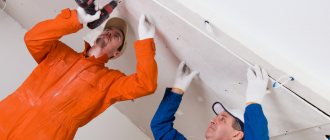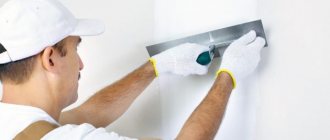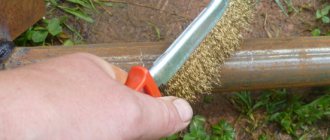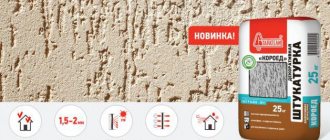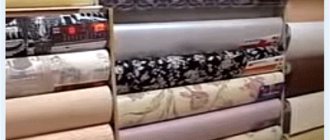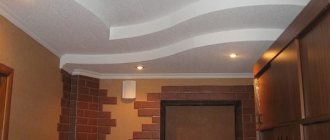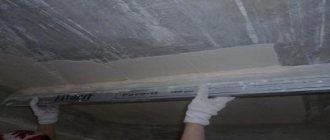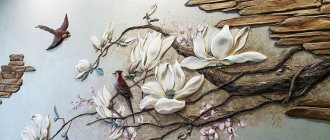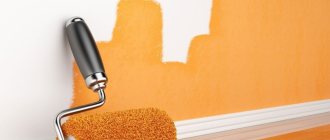The difference between latex and acrylic
First, it’s a good idea to find out how acrylic and latex paints differ, how compatible they are and how they can be mixed.
Latex in an aqueous solution contains rubber colloidal particles (synthetic) and emulsifiers. There are latex paints with natural latex - these are juices:
- poppy,
- Hevea,
- Dandelion.
They cost more, the differences are visible only to a specialist. Rubber particles based on the following bases act as artificial latex:
- Uretanova,
- Siloxanova,
- styrene butadiene,
- Isoprene,
- Acrylate.
Acrylic paint consists of acrylate copolymers and rubber filler, in most cases, styrene-butadiene group. As you can see, latex and acrylic are two boots of a pair - compositions on the same basis.
If you see the name “Acrylic paint with latex”, then don’t rack your brain, they just added butadiene styrene to the acrylic composition. This is done for one purpose - this reduces the cost of coating, since pure acrylic is expensive.
What are acrylic and latex?
Actually, acrylic paints are called that for ease of pronunciation. Acrylic is a polymer that is properly called polyacrylate plastic. There are many types of polyacrylates.
Natural latex is rubber. But latex, which is used for the production of paint mixtures, is a colloidal system, where rubber acts as a dispersed phase. Depending on the nature of the rubber, latex can be natural, which is very expensive, butadiene-styrene, acrylic, polyvinyl acetate, urethane, siloxane, etc.
Domestic manufacturers produce acrylic paints using latex technology. Real acrylic paint is produced in the USA without the use of latex dispersions, but on the basis of high-quality polyacrylates. Its differences from our domestic ones, produced on the basis of acrylate-styrene latex, are in much higher wear resistance, strength, and resistance to fading. But it is very expensive, and the difference in prices is quite large.
Why determine whether the paints on the surface are compatible with the paint used?
Paint and varnish materials often have to be applied to a surface that is already covered with some kind of paint and varnish material. These can be primers, putties, various enamels. They may differ in the pigments included in the composition and in the film-forming base. In order for the surface to be painted successfully, and for it to acquire an attractive appearance, it is necessary to ensure that the materials are compatible with each other.
If you attempt to coat over a material that is not compatible, the resulting surface will be of poor quality. Its appearance will be spoiled, and it is possible that soon after drying the paint will begin to crack and fall off. The composition will need to be removed soon and the painting work will need to be done again. This is not only time-consuming, but also very costly financially.
What are latex and acrylic paints made of?
Despite the different names of water-emulsion paints, they have almost the same composition of components, which include:
- Binders (polymers or copolymers, one or several at once) are particles responsible for adhesion (cohesion of dissimilar surfaces, that is, simply adhesion). Their characteristics increase the durability of the paint layer, abrasion resistance and other physical and mechanical properties;
- Solvent is a liquid (usually water) that combines all components and determines the structure of the mixture;
- Colors or colored pigments are substances that set the desired shade of a coloring material (more than 200 varieties). Usually it is a powder that does not dissolve in liquid and is suspended;
- Stabilizers are special additives that improve the properties of paint materials, or determine their area of use - for interior or exterior decoration, painting various types of surfaces;
- Fillers are surface-active components that are responsible for the resulting appearance of the dried layer of the mixture: brilliantly glossy, matte or semi-matte. In addition, special additions serve to improve the adhesion of the coloring material to different surfaces and increase the quality and reliability of the material.
The stage of regulating the water-based dispersion composition is quite simple. Microparticles of polymer and color are suspended in the volume of liquid - they do not dissolve and do not stick to each other. Before starting work, the material must be thoroughly mixed until smooth, and then you can begin painting.
In the applied layer, moisture gradually evaporates, thereby reducing the distance between suspended substances. When complete drying occurs, the polymer and pigment microparticles are tightly adhered to each other. Thanks to this, a thin, durable elastic film is formed.
Difference of terms
Natural latex is made from rubber, the sap extracted from the tropical Hevea tree, and in small quantities from the juice of dandelions.
It is clear that with the current scale of use of coloring compositions, natural raw materials would not be enough even to produce 1% of all mixtures.
Therefore, in the production of paint mixtures, chemical substitutes for latex with various polymers are used:
- isoprene;
- urethane;
- butadiene styrene;
- acrylate;
- polyvinyl acetate.
Or translated from English latex is an emulsion of dissolved polymer microparticles in water.
The polymer substance is acrylic, which is more accurately called polyacrylate plastic. There are many varieties of such polymers.
Latex paint and its types
Styrene-butadiene emulsion
The binding element in latex dyes is synthetic rubber based on copolymers.
It gives the raw materials for dyeing the following characteristics:
Latex paint
The types of paints and varnishes, depending on the components in the composition, are presented in the table.
| View | Characteristics | Which finish is it suitable for? |
| Polyvinyl acetate (water-based or water-dispersed) | Made from PVA glue, non-toxic, provides good adhesion to the surface. Disadvantages: unstable, easily washed off with water | For dry rooms |
| Butadiene-styrene | Resistant to water, but fades easily in sunlight | For bathrooms, toilets, corridors, basements |
| Acrylic | High-quality, suitable for interior work, facade finishing and painting exterior elements | For interior and exterior decoration |
| Acrylic-silicone | Reliable facade finishing with high durability | For facades and rooms with high humidity |
| Washable | Based on an acrylate binder polymer | For interior work |
| Rubber acrylate-latex | Creates a coating that is resistant to moisture, UV radiation, and temperature fluctuations, elastic and quick-drying. | For covering tennis courts, swimming pools, running tracks |
For interior work the following are most often used:
- vinyl
- acrylic
- dripless
- textured
- dense
Latex finishing compounds can give different finishing effects: matte, glossy or semi-matte.
Latex materials used:
- For external work (painting facades)
- For interior decoration (for walls and ceilings)
- For painting the floor
- For surface waterproofing
- Universal
Types of mixtures
Among the rich variety of water-based compounds, you must first understand what they are and what they can be used for.
Polyvinyl acetate dye
This type of mixture is known to many as an ordinary “water emulsion”. It is produced on the basis of the familiar PVA.
The most obvious advantages of this composition include:
- Affordability.
- No organic solvent.
- No unpleasant fragrance.
- Excellent grip.
The disadvantages include:
- Low resistance to abrasion and washing off by moisture, even after complete drying.
- If you run your hand over a painted surface, marks will remain on it, as if from whitewash.
- Frost intolerance. Over time it may become cracked and peel off from the surface.
Therefore, it is not recommended when working in areas with high humidity. It is best used for finishing ceilings in dry rooms.
Acrylic latex dye
If the composition contains only polymers of the acrylic group, then such a mixture is of higher quality and its service life is increased, and accordingly the price is also increased.
Rubber acrylate-latex mixture
High-tech products that form a thin but very durable, waterproof, elastic film. These mixtures have a very high degree of frost resistance and moisture resistance.
This is achieved using an optimally selected composition:
- The solvent is purified water;
- As an additive - antifreeze;
- The binding component is acrylate latex;
- A substance that accelerates film formation is a coalescent;
- Antibacterial components for protection – fungicides;
- To increase shelf life, use preservatives in sealed containers.
The rubber paint mixture allows air and steam to pass through well due to the microscopic pores that form after the composition dries. It also has anti-slip qualities, so it is perfect for covering porch steps, garden paths, and a swimming pool.
There are also paints with styrene-butadiene latex composition and acrylic-silicone mixtures.
What is acrylic paint
It refers to water-dispersed paints and varnishes. If you decipher it, all the features of the paint immediately come to the surface. Water, acrylic resin and tiny particles of coloring pigment are shaken up so that the droplets are evenly distributed among each other - this is called dispersion.
Thus, acrylic paint consists of the following components:
- water,
- acrylic resin,
- dye,
- filler (larger paint particles that make the coating more durable, adhesive, and matte or glossy),
- additional components that make each brand unique.
Operating principle After the paint is applied, it begins to dry - water evaporates from it. Resin droplets connect and create a monolithic layer that reliably embeds the coloring pigment.
Properties after drying
In liquid form, it is a light, almost odorless substance that is easy to apply and also easy to wash off. However, acrylic paint adheres excellently to almost any surface (which makes it universal), be it stone or plastic.
Is it possible to paint with acrylic paint over water-based paint?
Many people wonder what the difference is between acrylic water-dispersion and water-based paints. For domestic and professional purposes, both terms can be used.
The difference between acrylic water-dispersion and water-emulsion paints lies only in the breadth of concepts - dispersion implies the presence of small particles (liquid or solid) in the dispersion medium.
If these particles are liquids, then the dispersion is called an emulsion.
Suspensions, which are dispersed suspensions of solids, are not included in acrylic-based paints and varnishes. All acrylates are added to paints in the form of highly viscous liquids and belong to the class of emulsions.
Advantages and disadvantages
One of the main advantages of water-based paint is its affordable cost. The quality of this material is quite capable of competing with high-quality oil paints. Using the color scheme, you can easily choose the desired color shade.
But the most important advantage of water-based paint compared to its analogues is speed. It dries in the shortest possible time, sometimes just a few hours is enough.
It is noteworthy that during the treatment of the room you do not even need to leave the room. The dye is completely safe; it does not cause any harm to living organisms or the environment.
Another advantage is the absence of an unpleasant odor, which usually remains in the room for several weeks after finishing. Using various pigment dyes, the substance can be given absolutely any color of your choice.
Usually in construction stores there is a clear or white version on the counter, but it comes with a choice of additional pigment. This is necessary so that the buyer can independently choose the shade, and the seller will give the desired color on the spot.
The process of applying paint to any surface is very simple; after work, the tools can be cleaned without difficulty, the substance does not stick to them.
There is only one significant drawback of water-based paint. The fact is that the material can be applied to the surface only at a minimum air temperature of +5 degrees.
Features and Specifications
Acrylates have a number of useful qualities, which have led to their wide distribution in the domestic and professional sphere. The main advantages of water-dispersion compositions are:
- resistance to external mechanical stress and solar ultraviolet radiation;
- immunity to moisture (except for the cheapest low-quality paints);
- short drying time (a new layer can be applied an hour after the previous one);
- absence of toxic components and unpleasant odors during operation.
The operational parameters of water-based acrylic paints and their technical characteristics are standardized by GOST 28196-89. The standard establishes paint grades and regulates technical requirements for them. List of controlled parameters:
- color;
- appearance of the polymer film after the solvent has dried;
- proportion of non-volatile substances (resins and pigments);
- hiding power;
- light fastness;
- resistance to water;
- paint pH;
- drying time;
- frost resistance.
Water-dispersed acrylic paints are designated by the code “AK”. The nature of the solvent (water) is indicated by the abbreviation “VD”. In total, there are two brands of acrylic paints: brand “111” is universal (for exterior and interior work), and brand “111r” is designed to give the surface a relief structure.
Types of water-based acrylic compositions
- Facade. Suitable for decorating walls outside, they are vapor permeable and resistant to other external factors such as precipitation. The texture of the coating can be chosen embossed or smooth.
- Atmospheric. The best dye for cladding external coverings, regardless of the weather conditions of the area. In addition to resistance to weather conditions and temperature changes, the surface can withstand constant mechanical loads without deforming.
- Internal. Standard solutions suitable for decorating rooms. They are more convenient to apply than the previous options, but they remain in their original form less.
- Acrylic paints on wood. Due to the fact that wood is an environmentally friendly material, it is often coated with universal compounds to preserve its properties and appearance.
- Washable. They are used indoors, for painting the walls of the bathroom, toilet, and kitchen. They can be used for finishing technical rooms, where the likelihood of contamination of the walls is higher.
Pay attention to: Structural paint: main properties, types, advantages and method of application.
Exterior Acrylic Paint Interior Acrylic Paint Acrylic Wood Paint Washable Acrylic Paint
Sources used:
- https://classical4u.ru/stati/o-stroitelnyh-materialah/6674-vodoemulsionnaya-akrilovaya-kraska-osobennosti-materiala-i-primenenie.html
- https://kraskistroi.ru/vidy-krasok/vodoemulsionka/akrilovaya-vodoemulsionnaya-kraska.html
- https://stroyguru.com/remont-kvartiry/kakaya-kraska-luchshe-lateksnaya-ili-akrilovaya/
- https://remoskop.ru/vodojemulsionnaja-akrilovaja-kraska-dereva.html
- https://building-ooo.ru/uncategorized/kraska-vodoemulsionnaya-i-vsechto-nuzhno-o-nej-znat/.html
- https://dekoriko.ru/kraski/akrilovye/vodno-dispersionnaya/
- https://fasad-exp.ru/vidy-materialov-dlya-otdelki-fasadov/kraska/akrilatnye-kraski-po-derevu-dlya-naruzh.html
- https://mykrasim.ru/kraska/raznovidnosti-krasok/vodoemulsionnaya-akrilovaya-kraska
Popular manufacturers and cost of materials
The price of 1 kg of acrylic water-based paint (mixture) is 70-90 rubles. and more. The cheapest compounds have weak strength and anti-wear properties, so they can be easily wiped off mechanically after drying. Mixtures in the mid-price category (100-150 rubles/kg) are produced by many private entrepreneurs and are suitable for most areas of use.
It is better to purchase water-based paints in specialized stores that provide proper storage conditions for products sensitive to low temperatures. The vast majority of water-dispersion paints delaminate upon freezing and subsequent thawing, which makes them unsuitable for further use.
Well-known and popular manufacturers of acrylic water-based paint include:
- “Lakrit” is a wide range of acrylate dispersions covering a significant area of use (this acrylic water-based paint is intended for interior and exterior work, restoration, and has an average price);
- “Ultraweiss” is a durable acrylic paint that requires artificial tinting (available in the form of a white emulsion);
- "Tikkurila" is one of the highest quality compounds, characterized by high resistance, durability and cost;
- “Derufa” is one of the well-known domestically produced paints that forms durable and aesthetic coatings.
Acrylic water-based paint is also produced under the brand name “Caparol”, as discussed in the following video:
Consequences of improper mixing
In short, acrylic paint consists of:
- Binder,
- Copolymers,
- pigment,
- Thinner or solvent,
- filler,
- Additives.
For mixing without consequences, it is necessary that the binder, copolymers, filler and additives from this list match. It is desirable, but not necessary, for the pigments to match.
If you don’t want or don’t have time to study the composition, then take two simple rules into account:
- Mix the same type of paints,
- Do test mixing and test painting.
The following types of paints should not be mixed:
- Water-dispersion and water-emulsion,
- With and without silicone,
- On an organic and synthetic basis,
- Matte with glossy.
Types of such products
The following types of paints and varnishes are distinguished:
- atmospheric - withstands any weather conditions and is intended for external application on the surfaces of buildings and industrial structures;
- facade - used to protect the external parts of structures and can have a smooth or embossed texture of the polymer layer. This façade water-based acrylic paint is used on a par with atmospheric paint;
- for interior work – guarantees the effectiveness of the formed coating when working indoors. Such paints are often universal and are used simultaneously for internal and external application;
- washable - this water-based acrylic paint contains the highest quality acrylic binders, forming a durable polymer film that is not exposed to water. Conventional paints can only withstand dry cleaning and can “float” after wet cleaning;
- acrylic-based - the main component of the binder in this water-based paint is acrylates. A number of water-based paints that are not classified as acrylic can be made based on latex, vinyl acetate and other synthetic polymers. It’s quite difficult to say for sure which paint is better to buy (water-based latex, acrylic or another), it all depends on your requirements.
Today on store shelves it is not difficult to find acrylic-based water-based paints for many types of surfaces, including wood, as discussed in the review of the material in the following video:
Next, we will talk about whether it is possible to apply acrylic paint to water-based paint.
Varieties of mixture
There are several varieties of acrylic water-based paints, which are divided according to their purpose:
- Facade.
Used for painting external walls of buildings Properties of facade acrylic paint - Atmospheric.
Suitable for various external surfaces and has improved properties. Weather-resistant acrylic paint has good adhesion and durability in high humidity conditions - Internal.
It is used for indoor work and has excellent strength characteristics. Acrylic paint for interior work Expert - Washable. Contains latex, which allows for repeated wet cleaning. This option is intended for certain kitchen areas, hallways and bathrooms.
Acrylic washable paints can withstand about 1500 - 3000 cleaning cycles
Attention! The main thing when choosing is to give preference to trusted manufacturers and purchase goods in specialized stores.
Features of application and mixing
So, is it possible to mix water-based paint with acrylic paint? One of the advantages of acrylic water-dispersion paint is its high adhesion to a variety of surfaces. Application of acrylates over a hardened layer of water-based paint is allowed and is the main method of painting if stripping the old coating is not possible.
Acrylic water-based paints are an adequate replacement for non-aqueous based enamels. The availability of the compositions, non-toxicity and short drying time allow the use of acrylate mixtures for a wide range of economic and industrial purposes.
Application Tips
After selecting the coloring pigment, you can begin coloring. It is recommended to use a sprayer for this; due to the homogeneous consistency of the solution, it is evenly distributed with a spray gun over the surface of the wall or ceiling. However, you can also use a regular roller.
It is recommended to paint hard-to-reach places with a brush, which will ensure neatness and cleanliness of the work. You must first prepare the solution.
To do this, stir it thoroughly with a construction mixer, which prevents liquid separation, which reduces the technical characteristics of the composition. If necessary, add additional pigments at this stage to change the color scheme of the paint.
However, be careful - it is recommended to add pigment gradually to prevent the shade from becoming too saturated. Next, the technology for painting walls, floors or ceilings is standard:
Mixing Rules
If you need to mix several paints (collect the remains into a single whole), then pay attention to the following parameters of the compositions:
- Glossy-matte,
- Bright-pale,
- With or without marble chips,
- Presence of butadiene styrene - no,
- Type of rubber filler (natural-synthetic),
- Consistency.
By mixing gloss and matte composition, you get neither fish nor meat... you can paint a toilet with this paint, but not living rooms. The same applies to the brightness (saturation) of color - do not mix saturated and pale white colors.
Also, water-dispersion and water-based coatings should not be mixed. More on this in a little more detail.
Differences between water emulsion and water dispersion
Water-based dispersion paint consists of water, coloring pigment, polymer particles, as well as binders based on acrylic and silicone resins. The type of water dispersion composition can be acrylic and:
- Mineral,
- Silicone,
- Silicate.
The mineral composition is the most common; this coating contains lime or cement. Plus - low price, minus - fragility. Silicone material will please you with its moisture resistance, and silicate material is not afraid of fungi and mold.
A special emulsion is added to water-based paint - silicone resin, which makes the material wear-resistant and durable. The remaining components of the composition are identical. The advantages of VEC are described above, minus one is the higher price compared to VDK.
Consequences of improper mixing
In short, acrylic paint consists of:
- Binder,
- Copolymers,
- pigment,
- Thinner or solvent,
- filler,
- Additives.
For mixing without consequences, it is necessary that the binder, copolymers, filler and additives from this list match. It is desirable, but not necessary, for the pigments to match.
If you don’t want or don’t have time to study the composition, then take two simple rules into account:
- Mix the same type of paints,
- Do test mixing and test painting.
The following types of paints should not be mixed:
- Water-dispersion and water-emulsion,
- With and without silicone,
- On an organic and synthetic basis,
- Matte with glossy.
If you mix them, then stains are highly likely to appear on the surface, the paint layer will crack or begin to peel off even after priming.
Be sure to do a test mixing using a mixer - if different compositions turn into whey when merging and lose homogeneity, then they are not compatible. It is also important to paint an area of the surface with mixed paints, wait until it dries and evaluate the quality of the paint.
Varieties
As mentioned above, in addition to emulsion polymers, additional components are introduced into the composition of latex paint, which change the characteristics and, as a consequence, the scope of application of the material.
Based on PVA
Polyvinyl acetate paint is characterized by the following features:
- without smell;
- does not contain solvents;
- increased adhesion;
- easily washed off the body and clothes;
- affordable price.
This material is used mainly for painting ceilings, since after drying the treated surface, upon contact with clothing, leaves marks reminiscent of chalk. In addition, this composition is not frost and moisture resistant.
Latex based
Latex-based paint (or styrene-butadiene paint) has the same characteristics as the previous one. The difference between the compositions is that this one is moisture-resistant and wear-resistant. At the same time, the price of styrene-butadiene materials is comparable to PVA-based products.
This composition is also used for painting interior spaces. This is due to the fact that in case of contact with direct sunlight, the treated surface changes color.
Acrylic silicone
This product stands out from the previous ones due to the following features:
- does not fade in direct sunlight;
- withstands mechanical stress and contact with water;
- the dried layer is vapor permeable.
Acrylic silicone materials are often used for painting facades and other external works. Compared to silicone and silicate compounds, this one has practically no different characteristics, but is cheaper.
Acrylic
Acrylics are considered universal paints that are used for exterior and interior work. After drying, this composition is capable of maintaining its original characteristics for several years, regardless of external influences. Acrylic paints can be used on concrete, plastic, drywall and plaster. The main disadvantage of this material is its high price.
Acrylate-latex
This material is used mainly for external work, since after drying the painted surface acquires the following characteristics:
- ability to withstand temperature changes down to -50 degrees;
- moisture resistance;
- elasticity;
- wear resistance.
See also
Features of application and color of paint with hammer effect, top 4 compositions
Acrylate-latex paints allow walls to breathe and dry within two hours. Compared to other described compositions, this material is expensive.
What is the difference between regular latex paint and acrylic paint?
So, first, let's talk about how latex paint differs from acrylic paint. The main difference between them lies in the component composition and physicochemical properties. In addition to acrylic resins, such paints contain latex (rubber), which forms a more elastic and durable film after the thinner evaporates.
Acrylate paint and acrylic-based latex mixtures are often equated and given positive reviews. This is not entirely true, since purely latex compositions can be used without the addition of an acrylic binder. Their mutual combination expands the list of performance qualities and scope of use. And yet the difference between latex and acrylic paint is not very noticeable to the average user.
What is the difference?
The essence of all modern water-based painting materials is that they are latex. The different names are due only to the different incoming copolymers. Therefore, when selecting paint, you should carefully read the composition.
Copolymers of the acrylic group are used for the production of paints and varnishes of the same emulsion. Most often, polyacrylates with the addition of artificial rubber serve as binding components in these mixtures.
Latex coloring compositions are made based on styrene-butadiene polymers.
Acrylic and latex mixtures have a lot in common in their composition; their strengths and weaknesses are almost the same. The difference lies in only one important point: styrene-butadiene paints cannot be used for exterior or facade work - they are damaged by UV radiation and low temperatures.
What colors can be combined with what?
Very active components with a solvent effect are added to epoxy and polyurethane dyes - for example, acetone, xylene, cyclohexanone. Such mixtures should not be applied over physically cured reversible coatings as they will dissolve and create visible defects. Such coatings include vinyl, chlorinated rubber, nitrocellulose, and copolymer-vinyl chloride. If the same procedure is carried out over oxygen-curing materials, the coatings often begin to swell or peel off from the substrate.
Compatibility of silicate and epoxy paints
Silicate and organosilicon mixtures should not be applied to others, since most of them are chemically cured materials. The same goes for epoxy, polyurethane, polyvinyl butyral mixtures - they can only be applied over similar substances.
Acrylic paint compatibility
Vinyl and chlorinated rubber substances are suitable for painting traces of acrylic (latex), polyvinyl butyral, zinc silicate, and epoxy ester surfaces.
Alkyd paint compatibility
Oil or alkyd enamels are suitable for almost all types of coloring substances, except bitumen and pitch. Otherwise, migration of bitumen and pitches to the upper areas of the coating may occur, causing a change in color.
The procedure for staining
Before deciding on the choice of paint mixtures for repairs, it is advisable to obtain information regarding the composition of the coating. If it is not possible to clean it off, you should choose a similar material to renew the surface.
To avoid mistakes during coloring, it is recommended to carefully study the instructions for use of the selected mixture.
Acrylic copolymer based product
The acrylate binder in these paints can have a varied composition and contain copolymers - additional chains that modify quality parameters. The number of available copolymers is extensive and covers most needs for materials with special properties.
The latex component improves the characteristics of acrylic, making the paint more popular, although more expensive.
Features and Specifications
Common positive properties inherent in both acrylic and latex paints include:
- strength and durability of the resulting polymer layer;
- rich colors that do not lose brightness over time;
- stability under the influence of ultraviolet radiation from the sun;
- water base, which ensures the non-toxicity of the color mixture and the absence of unpleasant odors during operation.
Latex additives modify the strength and visual properties of acrylic paints, giving them the following characteristics:
- high elasticity - latex paints can be applied over embossed walls and wallpaper, since they follow any curves of the base well;
- aesthetics - rubber additives give the surface a visual silkiness;
- resistance to abrasion and water. Most latex paints are suitable for intensive washing, which cannot be said about ordinary acrylate compositions.
Product types
There is no strict classification of mixtures with rubber additives, although manufacturers usually indicate their properties and purpose in the information on the packaging. The most common types of paints are:
- matte, semi-matte and glossy - used for various purposes and surfaces. The glossy mixture is applied only to perfectly smooth walls or ceilings, since even minor irregularities and defects will become clearly visible under the gloss. Matte paint is better suited for less level walls and floors, while semi-matte acrylic copolymer latex paint has intermediate properties;
- facade, for walls, ceilings or floors - determine the main purpose of the paint. Although a significant part of the compositions are universal and can be used for identical purposes, it is better to follow the manufacturer's advice and apply the paint to suitable surfaces. And yet, the question often arises as to whether acrylic or silicone facade paint is better;
- washable, impact-resistant and moisture-resistant - characterize the main parameters of the coating after evaporation of the thinner (water). The properties of latex acrylic paints are similar to each other, so even mid-price compositions will provide high quality painted layers.
Material cost
The minimum price for acrylic latex paint is approximately 200 rubles/l. The cheapest products are from little-known companies. Sometimes ordinary acrylic dispersion is sold under the guise of latex paint, and the word “latex” appears only in the inscription on the label.
In order not to make a mistake with your choice, you should purchase products from more well-known manufacturers. The highest quality compositions can cost up to 1000 rubles/l or more, fully performing the functions assigned to rubber decorative coatings.
Below you will find a useful video on how to treat walls using acrylic latex paint Snezhka, and also learn about the advantages of this type of material:
Next we will talk about whether acrylic and latex paints can be mixed.
Is it possible to mix acrylic paint with water-based paint?
> Construction
You can mix paints and enamels only if they belong to the same group, that is, if they are designated by the same index. For example, organosilicon with organosilicon (KO), perchlorovinyl (PV), etc.
Paints of the alkyd group, designated by the indices MA (oil), GF (glyphthalic), PF (pentaphthalic) and FA (phenolic oil), are compatible with each other and can be mixed in any proportions and combinations.
Paints made on the basis of cellulose nitrate (NC), except within their own group, cannot be mixed with any others under any circumstances. They either simply won’t dry or will curl up immediately after mixing.
Water-based paints
also cannot be mixed with any others, since they are diluted with ordinary water.
Mix paints ONLY
one manufacturer! Production technology and formulations may vary from manufacturer to manufacturer, so paints of the same type are not always compatible.
To select the desired shade, it is better to first mix the paint in a small amount and do a test paint. Please take into account the fact that the color of the paint when wet may differ from the color that will be obtained in the final result.
Today, acrylic water-based paint is in great demand. It is especially justified that these paints are often used for exterior work, since they are particularly resistant to a wide variety of influences.
There are many varieties of such compositions, but acrylic and water-based paints stand out the most.
In order to understand the difference between these compounds, it is worth studying in detail their technical characteristics, advantages and features of use.
Water-based paint and its features
Water-based paint is made from water, and in addition to it, it includes polymer substances and pigment. Sometimes the water emulsion contains resins based on silicone or acrylic. To change the consistency of the composition, the use of certain solvents is required, which must be mixed with the water-based emulsion.
Water-based paint has the following advantages:
- Environmental friendliness due to the absence of toxic components in the composition;
- The area that is painted, during the drying process and after it, does not emit a pungent odor characteristic of other paints;
- Ease and convenience of application, requiring only the use of brushes and a roller;
- Possibility to change color using special pigments;
- Affordability.
In addition, water-based paint, depending on the composition, can be of several types:
- acrylic;
- silicone;
- mineral;
- silicate.
There are differences between these types in composition and application. Of all the listed types, an acrylic-based product is considered a universal composition, since it is used for a wide variety of surfaces.
Details about acrylic paint
Acrylic paints are mainly used for wall and ceiling structures, and even for some decorative elements. They include the following components:
- polymer acrylic emulsion;
- some of the dyes;
- distilled water.
Let's look at how acrylic paint differs from other media and its advantages:
- The composition dries quite quickly. It hardens within half an hour after application, and reaches full strength in a couple of days;
- High quality, and, consequently, long service life;
- The presence of a film that performs a protective function against moisture, temperature and ultraviolet rays;
- As a difference, it is worth remembering the versatility of the material, which allows it to be used both for painting during the repair process and for decorative painting;
- Environmental safety, allowing active use in the interior space of homes;
- Ease of use, allowing use without additional equipment and professional workers.
The difference between acrylic paint and water-based and other compositions is its versatility, high quality and long service life. The painted surface becomes bright and saturated.
The difference between acrylic paint and water-based paint
Let's look at the difference between water-based paint and acrylic paint. Everything is extremely simple. Water-based compositions are a broader type, divided into several types.
Acrylic composition is a type of water-based paint. Thanks to the additional components included in the mixture, a more advanced paint is obtained, differing from the usual water-based mixture in more practical qualities. It is also worth noting that the technical characteristics of this composition are more positive.
Acrylic water-based compositions are particularly resistant to various influences and cannot be washed off with water. This good characteristic of the material allows it to be used even outdoors.
The only significant drawback of an acrylic-based mixture is its high cost. But it is also offset by the cost-effectiveness of the application process.
Technical characteristics of water-based acrylic composition
Let's consider the main technical characteristics of water-based acrylic paint (WEAK):
- Viscosity, due to which the composition does not spread and is evenly distributed over the surface;
- Lightweight, which allows you to freely color even the thinnest materials;
- Covering power.
How to dilute water-based paint?
If a can of paint is left for a while, for example if it is leftover from painting something, it will thicken over time. This is due to a decrease in moisture in its composition, due to which elasticity and the ability to evenly cover surfaces are lost. How and with what can you dilute water-based paint?
It can be diluted with water, since it is a component of any such material. Due to the evaporation of water, the paint loses its original properties. But this can be easily fixed by adding regular drinking water to the jar and stirring it well using a construction mixer.
You can dilute it in a jar or clean bucket. You need to pour in the paint and water gradually, stirring constantly until you get the desired consistency. If it is necessary to give a certain color, then use color scheme. A certain amount of a dye of a suitable color is diluted in a small container with water-based paint. After this, the contents are gradually poured into a bucket with already diluted material until it reaches the desired shade.
How to dilute water-based paint?
Many users ask how to properly dilute water-based paint. This question comes up quite often. Your correct choice will guarantee a high-quality final result, as well as the durability of this coating. This way you will certainly avoid all the complications that may await you during construction work.
Is it possible to mix different formulations?
When preparing for painting work, it is not always possible to stock up on the required amount of paint and varnish material. Sometimes it is tempting to use different types of paints made on the same base to mix and apply together.
The water base of both paints will promote normal miscibility, but the quality of the polymer coating cannot be unequivocally guaranteed. Ready-made acrylic-based latex paints are manufactured in a factory, and their compositions are selected in the laboratory. If there is no strict need to use an artificial mixture of acrylic and latex water-based paints, it is better to avoid such a dubious experiment.
Acrylate latex paints are more expensive than conventional acrylic mixtures, but significantly expand the range of work performed. The strength of the resulting coating is higher and sufficient for intensive cleaning or washing. You should not use latex compounds everywhere - in some cases you can get by with standard acrylic paint for all types of surfaces.
When undertaking renovations in their own home, the owners try to think through every detail of the upcoming work and select the appropriate materials for it. Wallpaper, tiles, and stone can be used to decorate interior surfaces, but wall paint is most often used recently. Latex products, thanks to a number of positive qualities, stand out noticeably against the background of other coloring compositions, winning more and more sympathy from the consumer. For this reason, in today’s article we will pay attention specifically to latex paints, analyzing their types, properties and application technology.
How to apply?
Apply paint with a roller or paint brush. Usually it is applied in two or even three layers. It is important to apply each of the subsequent layers only after the previous one has dried.
Experts advise painting surfaces with water-dispersion paints at an air temperature of at least +5 °C.
We have already considered whether water-based paint can be diluted with water, and why yes. But an equally important question remains about how to do this in order to preserve its properties. Let's talk about this further.
Advantages of two compositions
Two CMs are made on a water basis. Therefore, they are characterized by general positive properties. It is impossible to visually distinguish the two coatings. Discrepancies appear during operation and when the constituent elements written on the can become known. General positive qualities:
- The coating resists the UV rays of the sun, which allows you to maintain the brightness of the shade. Some latex compounds lose color saturation over the course of their service life;
- there is no toxic odor or fumes harmful to health at the time of painting and throughout the service life;
- the covering layer is breathable, which eliminates the appearance of bubbles on the painted base;
- water in the composition is an environmentally friendly and safe solvent;
- the elastic covering layer fits well on surfaces of complex configuration;
- The coating of both compositions is silky.
Advantages and disadvantages
Since the paints being compared belong to the same type of water-based mixtures, their main strengths and weaknesses are similar. But there are still some differences.
Latex paints
Water-based mixtures with styrene-butadiene dispersed phase have many positive qualities:
- Low cost among all types of water-based coloring compositions;
- Long service life subject to certain operating conditions;
- High level of wear resistance;
- High resistance to moisture, which allows you to wash painted surfaces.
- Good elasticity - one layer of the mixture perfectly hides small defects;
- Lack of noticeable odor during use, which is observed with similar materials;
- Excellent adhesion to all types of products, even porous ones.
The weaknesses of the mixtures include:
- Burnout from ultraviolet rays;
- Poor tolerance to sudden changes in weather conditions and low temperatures. What does not allow the mixture to be used for painting facades;
- Mold and fungi may appear on the painted surface, which requires mandatory preliminary priming with the addition of antiseptic materials.
Attention! Today, latex coloring compositions for external use have appeared on the market, where the amount of the main binder polymer has been reduced.
Acrylic paints
This type of water-based mixtures looks much more attractive to consumers. He has a wide range of strengths:
- Long service life;
- Excellent adhesion to all types of building materials;
- Resistance to fading under the sun;
- Rich range of pigments;
- Cracks do not appear due to temperature changes;
- The addition of specialized fillers allows you to tolerate frosts down to minus 40 - minus 60 degrees;
- Under a layer of paint, the surface “breathes”;
We recommend: Aluminum cookware is harmful to health – another lie or the truth?
Among the few disadvantages are:
- Higher price compared to latex;
- The presence of an odor during operation, which disappears after the composition dries.
The main parameters by which water-based paint compositions are classified
Water-based coloring materials are divided according to several important characteristics, which include:
- Surface quality of the dried layer. The manufacturer is obliged to indicate what result will be obtained when painting: matte or glossy. Matte and semi-matte options are recommended to be applied to a leveled surface, otherwise all flaws will be noticeable. Glossy shine will cover minor defects. But absolutely glossy mixtures are not recommended for widespread use, since as a result they reflect bright light, which leads to rapid fatigue and pressure on the psycho-emotional state.
- Scope of application: for facade or interior work, covering ceilings, floors or walls.

